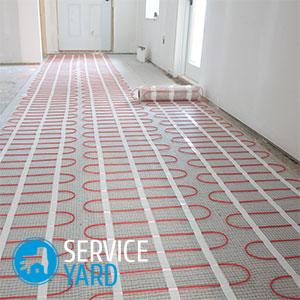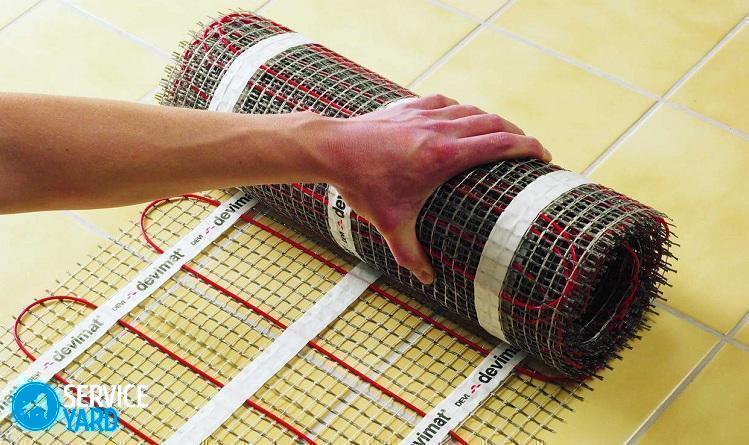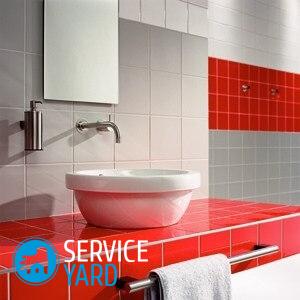Tile adhesive for underfloor heating

The underfloor heating system is becoming increasingly popular today. This method of heating the room is not only economical enough, but also allows you to distribute the temperature in the room with the maximum benefit for humans. In addition, you must agree that it is very pleasant to walk on such a floor. The best flooring for this is porcelain stoneware or ceramic tiles. When you purchase this material in any shopping center, you will be offered a special tile adhesive for a warm floor. We will find out whether it is so important to acquire special glue and how to choose it correctly.
to contents ↑The composition of the adhesive for underfloor heating
The entire “cake” of the warm floor is subjected to temperature changes, which leads to periodic expansion and contraction of materials. As a result, cracks, voids in the solution are formed, as a result - peeling of the tile. Emerging air cavities interfere with efficient floor heating.
Important! If you are still just at the design stage, be sure to read other useful publications on this topic:
To eliminate such problems when laying ceramic tiles and porcelain stoneware, tile adhesive is used on a warm floor, having a different composition than ordinary tile adhesives:
- The basis of all special compositions for underfloor heating is aluminate cements. Sometimes heat-resistant glue is prepared on the basis of epoxy resins.
- Additional components are added to the special tile adhesive under the warm floor, which make the solution heat-resistant and increase its ductility.
Important! The composition is intended for use at temperatures from -30 to +70 degrees. Therefore, laid on a warm floor, it does not suffer from constant heating and temperature changes.
- Polymer modifiers introduced into the composition of a special adhesive for underfloor heating allow avoiding the appearance of cracks during thermal compression and expansion of the floor during heating.
to contents ↑Important! If you use ordinary glue for laying tiles on a warm floor, then after some period of time (usually within a few months) you will need to completely replace the tile. This is fraught with additional costs and loss of valuable time. In this regard, it is necessary to apply that glue which is intended for a heat-insulated floor.
Types of glue
Almost all leading manufacturers produce special adhesive for underfloor heating for tiles, which is characterized by excellent performance. Such glue is suitable not only for ordinary floor ceramic tiles, but also for large-format models.
Important! Such repairs are usually done in such a way that they do not have to be redone after a year or two. Therefore, all materials used must be of good quality, and design - relevant. You can easily solve both of these problems by viewing ourRating of the best collections and manufacturers of tiles.
Each manufacturer uses its own set of fillers, but all of these mixtures are resistant to temperature extremes during operation and are divided into three types:
- The most popular tile adhesive for underfloor heating is a one-component composition. Its main advantage is ease of use.It is available as a paste and nothing else needs to be added to it. It has good strength and slowly hardens, which again is an advantage. It is possible to change the incorrect position of the elements.
- The two-component special adhesive consists of epoxy resin and polyurethane. In the store you get a dry mixture and hardener. First you mix these two ingredients, and then add water in the right proportions. Plus, such tile adhesive under the underfloor heating is the maximum strength with which it fastens the tile to the base.
- Also, construction stores offer universal adhesive for underfloor heating. It is based on the familiar and familiar cement.
to contents ↑Important! For facing the underfloor heating, experts recommend the use of cement mixtures made on the basis of cement M500. Such glue is able to withstand even difficult operating conditions without collapsing and without forming air voids under the tile.
Criterias of choice
When solving the problem, tile adhesive for underfloor heating - which is better, note that the material must meet the following performance characteristics:
- The determining quality should be resistance to temperature extremes. The operational temperature range of high-quality glue can be very wide - from minus 30 to plus 90 degrees, because it is used both in cold rooms and in pools.
- The finished adhesive should provide adhesion at a level of approximately 0.8 ÷ 1.0 MPa.
- It is very important that the adhesive is suitable for the finishing material. This indicator can always be found on the product packaging. For example, product brands such as “Ceresit” - CM 14 Extra, CM 16, CM 17, as well as CM 115, CM 117 and the brand “KeramikTermo” are best suited for underfloor heating.
- Ease of use. It is more convenient, of course, to work with ready-made tile adhesive for a warm floor, but they are much more expensive. Special cement-based dry building mixes have gained wider recognition from the craftsmen, as it is possible to produce as many mixes as needed at this stage of the work.
- Brand awareness and price level for adhesive. You should not buy too cheap mixtures of completely unknown manufacturers, as it will be uncomfortable to work with them, and no one will guarantee that the tile coating “behaves correctly” during the operation of the warm floor.
- The packaging must necessarily contain an inscription or graphic symbol about the purpose of this composition for the underfloor heating system.
to contents ↑Important! It is good if aluminate cement will be part of the tile adhesive under the warm floor. This component provides the strength of the coating and its resistance to mechanical stress.
Popular rating
Now we will consider what brand of adhesive for underfloor heating is the most popular, and why.
Tile adhesive CERESIT
Henkel has long been one of the world leaders in the construction industry. She produces a line of compounds under the brand name CERESIT:
- As tile glue, under the warm floor, CM 14 Extra, SM 16, SM 17, SM 115, SM 117 are perfect. There are plenty to choose from.
- Stamps under the numbers CM 14 Extra, CM 115 and CM 117 should be selected if you are laying tiles on hard concrete and cement substrates.
- SM 16 and SM 17 can be called universal, they can be used not only on concrete and cement, but also on drywall, chipboard, OSB, TsSP.
Important! Choosing this material, you need to take into account one more parameter. Not only on what basis will you glue, but also what exactly. Ceramic or marble tiles, porcelain tiles or mosaics.
KNAUF-Flex
Another brand known around the world, also has a good reputation among finishers. True, this manufacturer did not begin to market a series of compositions for different surfaces. In building stores you will find one type of tile adhesive for underfloor heating under the brand name KNAUF FLEX.
- Its main advantage is versatility.Such a composition can be used for both internal and external works.
- In this case, it does not matter if you lay the tile on a cement floor or on drywall. KNAUF FLEX perfectly grasps on any type of surface.
Dry building mixes Bergauf
This popular company also decided to ease the task of the finishers, and immediately released three types of glue for the underfloor heating under the tile:
- Composition under the brand name KERAMIK TERMO is perfect for facing stoves and fireplaces. It is able to withstand very high temperatures and their differences. For the installation of underfloor heating, it is very suitable.
- Tile adhesive for underfloor heating called KERAMIK EXPRESS can also be used for laying underfloor heating. Its main plus - it quickly hardens, hence the name - express. You can walk on the finished floor in a day.
- KERAMIK PRO possesses such necessary quality as high elasticity. It can be used for both external and external works.
Tile adhesive from Litokol
Litokol is an Italian company, and this country produces some of the best building materials. For tiles in its assortment there are several types of compositions:
- LITOFLEX K80 and K81 have an equally strong and heat-resistant composition, they are distinguished only by color. K80 has a gray tint, K81 is white.
- LITOSTONE K98 and K99 can be attributed to express formulations. They dry quickly enough, but at the same time create a strong adhesion of the tile to the floor.
TYPHOON MASTER №12
The young Belarusian company TYPHOON is also gaining popularity on the market today. Her brainchild is tiled glue under the warm floor above the simple name “Mixture under No. 12”:
- It is ideal for ceramic, marble, granite tiles.
- The mixture is also used for materials from natural and artificial stone. It has good elasticity and adhesion.
- Can be used for indoor and outdoor use.
to contents ↑Important! This is just a small list of materials that construction stores offer today. But, nevertheless, the most important thing became clear. When solving the issue, tile adhesive for a warm floor - which is better, you should pay special attention to what base the tiles will be laid on, and then choose the right one for the price.
Substrate preparation and glue preparation features
Even the best tile adhesive for underfloor heating will show itself only on the worse side if the surface is not prepared correctly:
- First, find out what is the floor level in your room. If the differences are more than 2 mm, then this is a problem. You can eliminate it using simple self-leveling materials. Apply it on the surface with a very thin layer, wait for it to dry completely, only then proceed with the installation of the warm floor.
- If there are no significant differences, but there are only small defects on the screed, then arm yourself with simple sandpaper. Small irregularities can be wiped manually or use a grinder.
- After work with a surface is finished, it needs to be washed thoroughly. Dirt particles impair grip, even when using the best glue. Therefore, it is necessary not only to thoroughly sweep out all the garbage or remove it with a vacuum cleaner, but also to degrease the surface. Please note that there should not be any oily stains on the base.
- Only after general cleaning proceed with the primer.
The process of preparing the adhesive solution from the dry mixture
It is necessary to work with tile adhesive under a warm floor, strictly observing the manufacturer's recommendations:
- As a basis, you can take an approximate scheme: for one kilogram of dry mix, two hundred milliliters of pure water should be used.
- Note that violation of the recommended proportions, dissolution order, and the maturation period of the solution will lead to a deterioration in its adhesive properties. And your tile will not be glued firmly enough.
- Do not make stocks of the mixture for future use - the adhesive may lose its properties when it is outdoors for a long time.Make an approximate calculation of the amount of glue that you use in the work over the next three hours.
The consumption of tile glue for warm depends on its brand, manufacturer and the rough basis of the floor. Provided that the surface is perfectly leveled, a layer of not more than 4 mm is sufficient:
- Many experts recommend applying the mixture to the tile itself - this will improve the adhesion of materials. The main thing is not to apply a layer of glue to the tile, but to smear the composition on it.
- The average consumption of the mixture is 5 kg of dry composition per square meter of area.
- If you took a lot more material, this indicates, first of all, that the base was not prepared well enough. The main consequence of this is that the work itself was not done at the proper level.
to contents ↑Important! During installation, you can not hope that the unevenness of the floor is aligned with glue. The thick installation layer will crack and the tiles will crumble.
Features of tile laying
If you want the glue for the underfloor heating under the tile to lie well and evenly, and the tile itself is kept for a long time and thoroughly, then it is worth taking every step of its installation with all responsibility. We have already talked about the importance of preparing the foundation; now we will move on to the sequence of steps. There are several of them:
- Prepare all necessary tile laying tools.
- Calculate the amount of mortar you need based on the size of the tiles used. For example, an element that has parameters 30 * 30 cm, it is necessary to cover the substance by 70-80%.
Important! The temperature in the room where tile adhesive is used under the underfloor heating is very important. The room should not be too hot, otherwise - the moisture will quickly evaporate from the glue. And it should not be too cold, otherwise - the same moisture will harden quickly. The most optimal for laying a warm floor is a temperature of +20 degrees Celsius.
- For good adhesion of the tile adhesive under the warm floor to the surface, moisten it. Note: it is to moisten, it is impossible to prevent excessive wetting of the concrete base.
- Then lay the tile. With the help of a notched trowel, on the reverse surface of the element we apply a layer of the mixture - from 3 to 5 mm thick, and evenly lay on our base.
- Leave 4 mm seams between the elements during installation. This will help you avoid any deformation of the floor while it is heating.
to contents ↑Important! After the tile is laid, you need to wait a day. And only then start grouting. Use only special formulations that, like glue, can withstand temperature extremes and heat. Our review will help you in choosing "Tile grout".
Stock footage
Special tile adhesive for underfloor heating is the key to success and a solid foundation for a high-quality finish. Savings on its purchase can lead to even greater costs. If, due to poor-quality material, the tile begins to lag behind the base, it will have to be redone again. And re-buy all the materials, not to mention the fact that you will need to spend even more time on the alteration. To make a warm floor under a tileu quite possibly on your own. You just need to follow the recommendations listed and listen to our tips.










